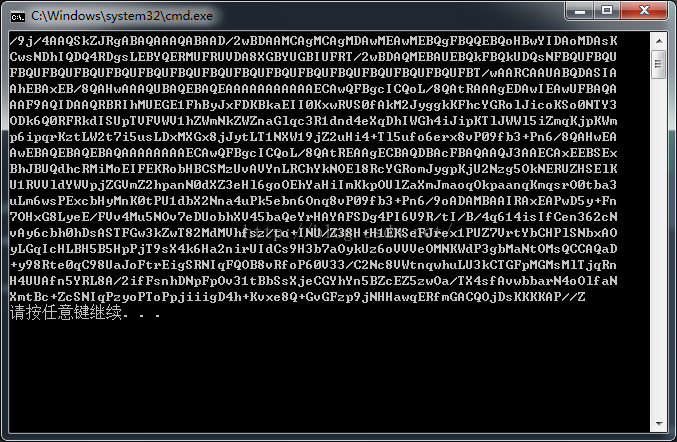转自:https://blog.youkuaiyun.com/hei_ya/article/details/51637929
1.base64编码的原因
网络传送渠道并不支持所有的字节,例如传统的邮件只支持可见字符的传送,像ASCII码的控制字符就不能通过邮件传送。这样用途就受到了很大的限制,比如图片二进制流的每个字节不可能全部是可见字符,所以就传送不了。最好的方法就是在不改变传统协议的情 况下,做一种扩展方案来支持二进制文件的传送。把不可打印的字符也能用可打印字符来表示,问题就解决了。Base64编码应运而生,Base64就是一种 基于64个可打印字符来表示二进制数据的表示方法。
2.base64编码原理
Base64编码的思想是是采用64个基本的ASCII码字符对数据进行重新编码。它将需要编码的数据拆分成字节数组。以3个字节为一组。按顺序排列24 位数据,再把这24位数据分成4组,即每组6位。再在每组的的最高位前补两个0凑足一个字节。这样就把一个3字节为一组的数据重新编码成了4个字节。当所要编码的数据的字节数不是3的整倍数,也就是说在分组时最后一组不够3个字节。这时在最后一组填充1到2个0字节。
ZBase64.h
- <span style="font-size:18px;">#include <string>
- using namespace std;
- class ZBase64
- {
- public:
- /*编码
- DataByte
- [in]输入的数据长度,以字节为单位
- */
- string Encode(const unsigned char* Data,int DataByte);
- /*解码
- DataByte
- [in]输入的数据长度,以字节为单位
- OutByte
- [out]输出的数据长度,以字节为单位,请不要通过返回值计算
- 输出数据的长度
- */
- string Decode(const char* Data,int DataByte,int& OutByte);
- };</span>
- string ZBase64::Encode(const unsigned char* Data,int DataByte)
- {
- //编码表
- const char EncodeTable[]="ABCDEFGHIJKLMNOPQRSTUVWXYZabcdefghijklmnopqrstuvwxyz0123456789+/";
- //返回值
- string strEncode;
- unsigned char Tmp[4]={0};
- int LineLength=0;
- for(int i=0;i<(int)(DataByte / 3);i++)
- {
- Tmp[1] = *Data++;
- Tmp[2] = *Data++;
- Tmp[3] = *Data++;
- strEncode+= EncodeTable[Tmp[1] >> 2];
- strEncode+= EncodeTable[((Tmp[1] << 4) | (Tmp[2] >> 4)) & 0x3F];
- strEncode+= EncodeTable[((Tmp[2] << 2) | (Tmp[3] >> 6)) & 0x3F];
- strEncode+= EncodeTable[Tmp[3] & 0x3F];
- if(LineLength+=4,LineLength==76) {strEncode+="\r\n";LineLength=0;}
- }
- //对剩余数据进行编码
- int Mod=DataByte % 3;
- if(Mod==1)
- {
- Tmp[1] = *Data++;
- strEncode+= EncodeTable[(Tmp[1] & 0xFC) >> 2];
- strEncode+= EncodeTable[((Tmp[1] & 0x03) << 4)];
- strEncode+= "==";
- }
- else if(Mod==2)
- {
- Tmp[1] = *Data++;
- Tmp[2] = *Data++;
- strEncode+= EncodeTable[(Tmp[1] & 0xFC) >> 2];
- strEncode+= EncodeTable[((Tmp[1] & 0x03) << 4) | ((Tmp[2] & 0xF0) >> 4)];
- strEncode+= EncodeTable[((Tmp[2] & 0x0F) << 2)];
- strEncode+= "=";
- }
- return strEncode;
- }
- string ZBase64::Decode(const char* Data,int DataByte,int& OutByte)
- {
- //解码表
- const char DecodeTable[] =
- {
- 0, 0, 0, 0, 0, 0, 0, 0, 0, 0, 0, 0, 0, 0, 0, 0, 0, 0, 0, 0, 0, 0, 0, 0,
- 0, 0, 0, 0, 0, 0, 0, 0, 0, 0, 0, 0, 0, 0, 0, 0, 0, 0, 0,
- 62, // '+'
- 0, 0, 0,
- 63, // '/'
- 52, 53, 54, 55, 56, 57, 58, 59, 60, 61, // '0'-'9'
- 0, 0, 0, 0, 0, 0, 0,
- 0, 1, 2, 3, 4, 5, 6, 7, 8, 9, 10, 11, 12,
- 13, 14, 15, 16, 17, 18, 19, 20, 21, 22, 23, 24, 25, // 'A'-'Z'
- 0, 0, 0, 0, 0, 0,
- 26, 27, 28, 29, 30, 31, 32, 33, 34, 35, 36, 37, 38,
- 39, 40, 41, 42, 43, 44, 45, 46, 47, 48, 49, 50, 51, // 'a'-'z'
- };
- //返回值
- string strDecode;
- int nValue;
- int i= 0;
- while (i < DataByte)
- {
- if (*Data != '\r' && *Data!='\n')
- {
- nValue = DecodeTable[*Data++] << 18;
- nValue += DecodeTable[*Data++] << 12;
- strDecode+=(nValue & 0x00FF0000) >> 16;
- OutByte++;
- if (*Data != '=')
- {
- nValue += DecodeTable[*Data++] << 6;
- strDecode+=(nValue & 0x0000FF00) >> 8;
- OutByte++;
- if (*Data != '=')
- {
- nValue += DecodeTable[*Data++];
- strDecode+=nValue & 0x000000FF;
- OutByte++;
- }
- }
- i += 4;
- }
- else// 回车换行,跳过
- {
- Data++;
- i++;
- }
- }
- return strDecode;
- }
3.使用示例(结合opencv)
main.cpp
- <span style="font-size:18px;">#include<opencv2/opencv.hpp>
- #include<iostream>
- #include"ZBase64.h"
- #include<vector>
- using namespace std;
- using namespace cv;
- void main()
- {
- Mat img = imread("1.bmp");
- vector<uchar> vecImg; //Mat 图片数据转换为vector<uchar>
- vector<int> vecCompression_params;
- vecCompression_params.push_back(CV_IMWRITE_JPEG_QUALITY);
- vecCompression_params.push_back(90);
- imencode(".jpg", img, vecImg, vecCompression_params);
- ZBase64 base64;
- string imgbase64 = base64.Encode(vecImg.data(), vecImg.size()); //实现图片的base64编码
- cout << imgbase64 << endl;
- }</span>







 本文详细介绍了Base64编码的背景、原理及其在图片等二进制数据传输中的应用,并提供了C++实现示例。
本文详细介绍了Base64编码的背景、原理及其在图片等二进制数据传输中的应用,并提供了C++实现示例。
















 6040
6040

 被折叠的 条评论
为什么被折叠?
被折叠的 条评论
为什么被折叠?








